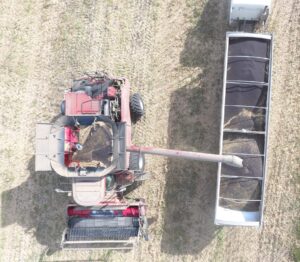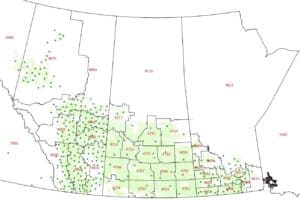The most profitable canola yield target varies by field and by year. Crop plans, input decisions and profit outlooks benefit from an appropriate yield target for each field each year.
In some cases, farms may expect too much of fields or low-yielding areas within fields. They over-apply inputs and profitability drops. In other cases, some fields or high-yielding areas within fields may underachieve because the yield target and fertilizer rates are too low.
This article will discuss:

How to calculate a target yield
Farmers and their agronomists can set appropriate yield targets for the year based on some or all of the following factors.
Soil test data and recommendations
Soil test results include fertilizer rate guidelines based on soil test results cross referenced with a farm’s own yield target. Some labs provide fertilizer guidelines for a range of yield targets.
Farms can also share raw soil nutrient data with an agronomist and discuss an appropriate yield target with them. Agronomists will consider field soil type, the farmer’s appetite for risk and the agronomist’s experience with local potential to advise on a yield target that could increase profitability.
Source: Soil analysis labs
Available moisture
Soil moisture reserves heading into the growing season can significantly influence the target yield. Large soil moisture reserves helped canola growers in the Eastern Prairies achieve higher than expected canola yields in 2023. In-season moisture was far too low for the yields achieved.
Sources: In-field electronic moisture sensors, mechanical soil moisture probes (like the Brown soil probe) and provincial weather data.
- Manitoba: Fall soil moisture survey results
- Saskatchewan: The province’s Water Security Agency provides an annual Conditions at Freeze Up report. Here is the fall 2024 report.
- Alberta: Alberta weather station data includes soil moisture measurement at depths up to one metre.
Typical average yields for the broader area
Farms can use yield data from the whole region to re-evaluate their yield performance and potential. High yields do not always mean high profits, but if the farm is below local yield thresholds, it will prompt some discussion as to why.
Sources:
Crop insurance. Farm reports often compare field results to regional averages. Crop insurance also provides provincial and risk area results.
- Manitoba: MASC online yield data, Yield Manitoba and Manitoba Management Plus Program
- Saskatchewan: SCIC online yield data (Check yield by risk zone); Yield Saskatchewan and Sask Management Plus
- Alberta: Yield Alberta. The Yield Estimation Calculator for Annual Crops can help assess mid-season crop growth.
Agronomist. Agronomists and agronomy service companies will have a good handle on yield potential in the area, and can relate that to individual field characteristics.
Statistics Canada. StatCan has yield by data region. Use “add/remove data” to create yield history by crop and year for small area data regions. Use the map below to find your region.

The farm’s historic canola yield
This is an important factor but it may be flawed. More profitable yield targets are often higher than historic yields, especially if new genetics, improved pest management products and 4R nutrient management can elevate yield potential. Targets based on historic yields essentially mean the farm locks in a yield plateau.
Sources: Yield maps and farm records, including crop insurance reports.
The farm’s cost of production and profit
Calculate the input costs to produce canola and observe how those costs and profits change based on different target yields. Try the historical average for a specific field, for the farm, for the region – the numbers collected from the above steps. Then try an aspirational yield, perhaps based on the farm’s best-ever result – or even higher.
An example...
Canola Council of Canada agronomy specialist Jason Casselman ran a few sample scenarios using the Saskatchewan 2024 Crop Planner Calculator. He chose a fertilizer blend of 80-30-20-10, enough for a target 40 bu./ac. canola crop, is around $85 per acre. Then he doubled rate, which increased the cost to $170 per acre.
Using the calculator, total cost for a 40 bu./ac. crop is $14.09 per bushel, or $563.88 per acre. Hypothetically, if the doubled fertilizer rate can double yields, the cost for an 80 bu./ac. crop rises to $618.49 per acre while the cost per bushel falls to $7.73.And because revenue per acre at $13 per bushel doubles from $520 per acre for the 40-bushel crop to $1,040 per acre for the 80-bushel crops, profits go from a loss at 40 bu./ac. to a gain of over $400 per acre at 80 bu./ac.
Of course, the doubled yield is highly unlikely, perhaps impossible. But this demonstrates the point.
Even if fertilizing for a 50 bu./ac., and yield increases to the high 40s, the scenario moves from a loss to a profit. As Casselman says, if you don’t fertilize for higher yield – if the potential is there – the crop cannot reach that potential.
If yields in the end don’t match fertilizer rates, those fertilizer inputs will be available the following year (except perhaps for some nitrogen in particularly wet areas of a field).
Sources: Farm records and provincial cost of production guides.
- Manitoba Cost of Production Guide & Calculator
- Manitoba Cost of Production Guide PDF
- Saskatchewan Crop Planning Guide and Crop Planner
- Alberta Cropping Alternatives: Crop budget planning
Tips to achieve higher yields
Farmers have a lot list of ways to achieve higher canola yields. Here are a few key suggestions, some of which can increase yield without adding cost.
Try new cultivars
Experiment with at least one new cultivar each year. Rather than put that cultivar in its own field, seed a block through the middle of a field of the farm’s current favourite cultivar. That way the two cultivars get a head to head test in the same field with the same soil type, weather and field history. The cultivar decision includes seed treatment to protect against flea beetle, cutworms and blackleg – if those are yield-limiting threats on the farm. Choose the right cultivar for each field
Apply more fertilizer
Nitrogen tends to drive yield (unless other nutrients are deficient, then it doesn’t). A 52 bu./ac. canola crop removes 130 to 220 lb./ac. of nitrogen, according to the latest guidelines. However, 2017-21 average nitrogen rates for Canadian canola were 119 lb./ac., according to Fertilizer Canada surveys. Basically, growers are fertilizing for a 41 bu./ac. canola crop.
A series of small in-field trials could help set a higher yet reasonable nitrogen rate. Whatever nitrogen rate you use, try a few strips with 125 or 150 per cent of that rate. Map those strips on the drill monitor map or with actual flags. Compare yields with the combine yield monitor or, ideally, use carts with scales for more accuracy. These tests done each year will help identify yield potential and most profitable nitrogen rates for the farm.
Trial results may support existing practices or identify a potential adjustment. In some cases, nitrogen may not be the limiting factor. Or perhaps weather and soil conditions simply don’t support higher yields. All of these are valuable learnings. How much nutrient does canola need?
Apply an appropriate nutrient balance
This is an important qualifier to the previous heading… In some cases, adding more of one specific nutrient is not the answer. Soil sampling, including targeted soil sampling, can identity nutrient shortages that may affect yield potential.
Crops with adequate and balanced nutrition are often more likely to fend off disease or insect threats.
Achieve uniform, rapid establishment of enough plants
Farmers want a canola stand that emerges uniformly and rapidly, with five to eight plants per square foot. This crop is more likely to withstand flea beetle pressure and facilitates more efficient fungicide application and harvest. That ultimately leads to higher yield and increased profits. How to increase canola seed survival rates
Control pests
Top genetics with appropriate seed treatment, adequate balanced nutrition and rapid, uniform emergence of five to eight plants per square foot give canola crops a leg-up on pests.
Even so, timely protection from weeds, insects and diseases is a key yield booster. Early weed control may not cost more than late weed control, but can make a big difference to yield. Insect control based on thresholds and sclerotinia stem rot fungicide based on risk assessment at early flowering can also increase yield, and profit.
Swath on the late side
Swath canola after seeds have at least 60 per cent colour change on the main stem and when seeds in side branches are firm to roll. That allows the crop to reach its maximum yield potential.
Minimize harvest loss
Check for losses out the back of the combine, and adjust settings to keep loss to below one per cent. Profit margins unravel quickly when harvest losses are high.
Provide breaks between canola crops
Tight rotations will reduce yield for any crop. This is proven in research trials and in crop insurance data.
More…
Canola Digest: How to elevate yields
